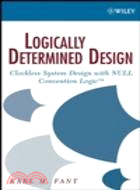Logically Determined Design: Clockless System Design With Null Convention Logic
商品資訊
ISBN13:9780471684787
出版社:John Wiley & Sons Inc
作者:Fant
出版日:2005/01/11
裝訂/頁數:平裝/310頁
定價
:NT$ 8998 元優惠價
:
90 折 8098 元
若需訂購本書,請電洽客服 02-25006600[分機130、131]。
商品簡介
作者簡介
目次
商品簡介
This seminal book presents a new logically determined design methodology for designing clockless circuit systems. The book presents the foundations, architectures and methodologies to implement such systems. Based on logical relationships, it concentrates on digital circuit system complexity and productivity to allow for more reliable, faster and cheaper products.
* Transcends shortcomings of Boolean logic.
* Presents theoritical foundations, architecture and analysis of clockless (asynchronous) circuit design.
* Contains examples and exercises making it ideal for those studying the area.
* Transcends shortcomings of Boolean logic.
* Presents theoritical foundations, architecture and analysis of clockless (asynchronous) circuit design.
* Contains examples and exercises making it ideal for those studying the area.
作者簡介
KARL M. FANT is President of Theseus Research, Inc. After serving as a Research Fellow at Honeywell, he co-founded Theseus Research and then Theseus Logic, which is now commercializing NULL Convention LogicTM. He holds twenty-nine patents and has published numerous papers.
目次
Preface.
Acknowledgments.
1. Trusting Logic.
1.1 Mathematicianless Enlivenment of Logic Expression.
1.2 Emulating the Mathematician.
1.3 Supplementing the Expressivity of Boolean Logic.
1.4 Defining a Sufficiently Expressive Logic.
1.5 The Logically Determined System.
1.6 Trusting the Logic: A Methodology of Logical Confidence.
1.7 Summary.
1.8 Exercises.
2. A Sufficiently Expressive Logic.
2.1 Searching for a New Logic.
2.2 Deriving a 3 Value Logic.
2.3 Deriving a 2 Value Logic.
2.4 Compromising Logical Completeness.
2.5 Summary.
3. The Structure of Logically Determined Systems.
3.1 The Cycle.
3.2 Basic Pipeline Structures.
3.3 Control Variables and Wavefront Steering.
3.4 The Logically Determined System.
3.5 Initialization.
3.6 Testing.
3.7 Summary.
3.8 Exercises.
4. 2NCL Combinational Expression.
4.1 Function Classification.
4.2 The Library of 2NCL Operators.
4.3 2NCL Combinational Expression.
4.4 Example 1: Binary Plus Trinary to Quaternary Adder.
4.5 Example 2: Logic Unit.
4.6 Example 3: Minterm Construction.
4.7 Example 4: A Binary Clipper.
4.8 Example 5: A Code Detector.
4.9 Completeness Sufficiency.
4.10 Greater Combinational Composition.
4.11 Directly Mapping Boolean Combinational Expressions.
4.12 Summary.
4.13 Exercises.
5. Cycle Granularity.
5.1 Partitioning Combinational Expressions.
5.2 Partitioning the Data Path.
5.3 Two-dimensional Pipelining: Orthogonal Pipelining Across a Data Path.
5.4 2D Wavefront Behavior.
5.5 2D Pipelined Operations.
5.6 Summary.
5.7 Exercises.
6. Memory Elements.
6.1 The Ring Register.
6.2 Complex Function Registers.
6.3 The Consume/Produce Register Structure.
6.4 The Register File.
6.5 Delay Pipeline Memory.
6.6 Delay Tower.
6.7 FIFO Tower.
6.8 Stack Tower.
6.9 Wrapper for Standard Memory Modules.
6.10 Exercises.
7. State Machines.
7.1 Basic State Machine Structure.
7.2 Exercises.
8. Busses and Networks.
8.1 The Bus.
8.2 A Fan-out Steering Tree.
8.3 Fan-in Steering Trees Do Not Work.
8.4 Arbitrated Steering Structures.
8.5 Concurrent Crossbar Network.
8.6 Exercises.
9. Multi-value Numeric Design.
9.1 Numeric Representation.
9.2 A Quaternary ALU.
9.3 A Binary ALU.
9.4 Comparison.
9.5 Summary.
9.6 Exercises.
10. The Shadow Model of Pipeline Behavior.
10.1 Pipeline Structure.
10.2 The Pipeline Simulation Model.
10.3 Delays Affecting Throughput.
10.4 The Shadow Model.
10.5 The Value of the Shadow Model.
10.6 Exercises.
11. Pipeline Buffering.
11.1 Enhancing Throughput.
11.2 Buffering for Constant Rate Throughput.
11.3 Summary of Buffering.
11.4 Exercises.
12. Ring Behavior.
12.1 The Pipeline Ring.
12.2 Wavefront-limited Ring Behavior.
12.3 The Cycle-to-Wavefront Ratio.
12.4 Ring Signal Behavior.
13. Interacting Pipeline Structures.
13.1 Preliminaries.
13.2 Example 1: The Basics of a Two-pipeline Structure.
13.3 Example 2: A Wavefront Delay Structure.
13.4 Example 3: Reducing the Period of the Slowest Cycle.
13.5 Exercises.
14. Complex Pipeline Structures.
14.1 Linear Feedback Shift Register Example.
14.2 Grafting Pipelines.
14.3 The LFSR with a Slow Cycle.
14.4 Summary.
14.5 Exercises.
Appendix A: Logically Determined Wavefront Flow.
A.1 Synchronization.
A.2 Wavefronts and Bubbles.
A.3 Wavefront Propagation.
A.4 Extended Simulation of Wavefront Flow.
A.5 Wavefront and Bubble Behavior in a System.
Appendix B: Playing with 2NCL.
B.1 The SR Flip-flop Implementations.
B.2 Initialization.
B.3 Auto-produce and Auto-consume.
Appendix C: Pipeline Simulation.
References.
Index.
Acknowledgments.
1. Trusting Logic.
1.1 Mathematicianless Enlivenment of Logic Expression.
1.2 Emulating the Mathematician.
1.3 Supplementing the Expressivity of Boolean Logic.
1.4 Defining a Sufficiently Expressive Logic.
1.5 The Logically Determined System.
1.6 Trusting the Logic: A Methodology of Logical Confidence.
1.7 Summary.
1.8 Exercises.
2. A Sufficiently Expressive Logic.
2.1 Searching for a New Logic.
2.2 Deriving a 3 Value Logic.
2.3 Deriving a 2 Value Logic.
2.4 Compromising Logical Completeness.
2.5 Summary.
3. The Structure of Logically Determined Systems.
3.1 The Cycle.
3.2 Basic Pipeline Structures.
3.3 Control Variables and Wavefront Steering.
3.4 The Logically Determined System.
3.5 Initialization.
3.6 Testing.
3.7 Summary.
3.8 Exercises.
4. 2NCL Combinational Expression.
4.1 Function Classification.
4.2 The Library of 2NCL Operators.
4.3 2NCL Combinational Expression.
4.4 Example 1: Binary Plus Trinary to Quaternary Adder.
4.5 Example 2: Logic Unit.
4.6 Example 3: Minterm Construction.
4.7 Example 4: A Binary Clipper.
4.8 Example 5: A Code Detector.
4.9 Completeness Sufficiency.
4.10 Greater Combinational Composition.
4.11 Directly Mapping Boolean Combinational Expressions.
4.12 Summary.
4.13 Exercises.
5. Cycle Granularity.
5.1 Partitioning Combinational Expressions.
5.2 Partitioning the Data Path.
5.3 Two-dimensional Pipelining: Orthogonal Pipelining Across a Data Path.
5.4 2D Wavefront Behavior.
5.5 2D Pipelined Operations.
5.6 Summary.
5.7 Exercises.
6. Memory Elements.
6.1 The Ring Register.
6.2 Complex Function Registers.
6.3 The Consume/Produce Register Structure.
6.4 The Register File.
6.5 Delay Pipeline Memory.
6.6 Delay Tower.
6.7 FIFO Tower.
6.8 Stack Tower.
6.9 Wrapper for Standard Memory Modules.
6.10 Exercises.
7. State Machines.
7.1 Basic State Machine Structure.
7.2 Exercises.
8. Busses and Networks.
8.1 The Bus.
8.2 A Fan-out Steering Tree.
8.3 Fan-in Steering Trees Do Not Work.
8.4 Arbitrated Steering Structures.
8.5 Concurrent Crossbar Network.
8.6 Exercises.
9. Multi-value Numeric Design.
9.1 Numeric Representation.
9.2 A Quaternary ALU.
9.3 A Binary ALU.
9.4 Comparison.
9.5 Summary.
9.6 Exercises.
10. The Shadow Model of Pipeline Behavior.
10.1 Pipeline Structure.
10.2 The Pipeline Simulation Model.
10.3 Delays Affecting Throughput.
10.4 The Shadow Model.
10.5 The Value of the Shadow Model.
10.6 Exercises.
11. Pipeline Buffering.
11.1 Enhancing Throughput.
11.2 Buffering for Constant Rate Throughput.
11.3 Summary of Buffering.
11.4 Exercises.
12. Ring Behavior.
12.1 The Pipeline Ring.
12.2 Wavefront-limited Ring Behavior.
12.3 The Cycle-to-Wavefront Ratio.
12.4 Ring Signal Behavior.
13. Interacting Pipeline Structures.
13.1 Preliminaries.
13.2 Example 1: The Basics of a Two-pipeline Structure.
13.3 Example 2: A Wavefront Delay Structure.
13.4 Example 3: Reducing the Period of the Slowest Cycle.
13.5 Exercises.
14. Complex Pipeline Structures.
14.1 Linear Feedback Shift Register Example.
14.2 Grafting Pipelines.
14.3 The LFSR with a Slow Cycle.
14.4 Summary.
14.5 Exercises.
Appendix A: Logically Determined Wavefront Flow.
A.1 Synchronization.
A.2 Wavefronts and Bubbles.
A.3 Wavefront Propagation.
A.4 Extended Simulation of Wavefront Flow.
A.5 Wavefront and Bubble Behavior in a System.
Appendix B: Playing with 2NCL.
B.1 The SR Flip-flop Implementations.
B.2 Initialization.
B.3 Auto-produce and Auto-consume.
Appendix C: Pipeline Simulation.
References.
Index.
主題書展
更多
主題書展
更多書展購物須知
外文書商品之書封,為出版社提供之樣本。實際出貨商品,以出版社所提供之現有版本為主。部份書籍,因出版社供應狀況特殊,匯率將依實際狀況做調整。
無庫存之商品,在您完成訂單程序之後,將以空運的方式為你下單調貨。為了縮短等待的時間,建議您將外文書與其他商品分開下單,以獲得最快的取貨速度,平均調貨時間為1~2個月。
為了保護您的權益,「三民網路書店」提供會員七日商品鑑賞期(收到商品為起始日)。
若要辦理退貨,請在商品鑑賞期內寄回,且商品必須是全新狀態與完整包裝(商品、附件、發票、隨貨贈品等)否則恕不接受退貨。













